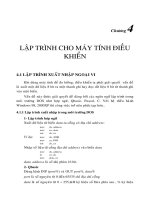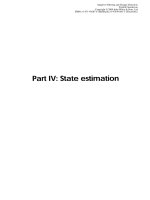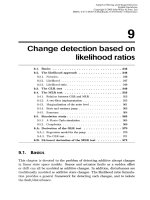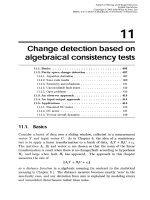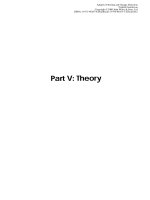Turbine gen alternator TB5000
Bạn đang xem bản rút gọn của tài liệu. Xem và tải ngay bản đầy đủ của tài liệu tại đây (7.11 MB, 187 trang )
Instruction Book
No.S4106001 2105
INSTALLATION, OPERATION & MAINTENANCE
INSTRUCTION BOOK
The equipment described in this manual was supplied to:
Ruston Gas Turbines Ltd. for. Hamilton Brothers Oil & Gas Ltd.
for Argyll/Duncan F.P.F.
on Order No.97087
Correspondence relating to the equipment should quote the
GEC Large Machines Limited reference:
The following information should also be given:
Machine
(a) Serial number
(b) Frame size
These two items are given on the machine rating plate and
in the Technical Data section of this manual.
0
GEC Large Machines Limited
Mill Road, RUGBY
Warwickshire, ENGLAND
CV21 1BD
Though the instructions and information given in this book are as
explicit as is practical , expertise is still required to install
and maintain machines . If trouble- free service is to be obtained,
the machines and any auxiliary drive must be installed, set and
checked correctly even though , in some cases , they may have been
supplied fully assembled.
For the erection and commissioning of the equipment supplied, the
services of GEC Large Machines Limited outside construction staff
are strongly recommended ; they have special knowledge of design
details and of suitable erection and checking techniques.
THE HEALTH AND SAFETY AT WORK ACT 1974
The Purchaser should comply with the instructions and
information in this manual , and is strongly advised that
all personnel to be associated with the equipment supplied
under the contract should be made familiar with the
information contained herein.
It is essential that the personnel engaged on the
installation , commissioning and maintenance of this
equipment are both competent and experienced in these
fields, and that they comply with the relevant statutory
requirements and regulations , including the provisions
of the Health & Safety Act , 1974, and any such modifications and amendments which may subsequently become a legal
requirement.
CONTENTS
1.0 TECHNICAL DATA
1.1 For Generator
1.2 For Exciter
2.0 DESCRIPTION
2.1 General
2.2 Bearings
2.3 Cooler
2.4 Illustrations
3.0 INSTALLATION & COMMISSIONING
3.1 Preliminary inspection and storage
3.2 Lifting and handling
3.3 Location
3.5 Oil-lubricated plain bearings - storage and assembly
3.7 Approved lubricants
3.9 Oils
3.10 Alignment
3.12 Flexible couplings
3.13 Dowelling of machines
3.15 Earthing
3.16 Insulation resistance tests
3.17 Removal of moisture
3.18 Methods of drying out windings
3.19 Phasing and connection
3.29 'Elastimold' plug-in connectors ( see also 5.8)
3.31 Neutral terminal box accommodating C.Ts
3.35 Bearing insulation
3.37 CACA coolers ( see also 4.19)
3.39 Putting machine into service - check list ( M/c. with cooler)
3.40 Paralleling
4.0 OPERATION & ROUTINE MAINTENANCE
4.1 General
4.2 Windings
4.3 Adjustment of air-gap
4.9 Pressure- fed plain bearing - operation and maintenance
4.14 Shaft- mounted . rectifier diodes
4.15 A.C. exciter
4.16 Permanent magnet pilot - exciter ( P.M.G.)
4.19 CACA coolers ( see also 3.37)
5.0 OVERHAUL
5.1 Dismantling of generator - general
5.2 Drying out (see 3.16 , 3.17 and 3.18)
5.8 Dismantling of 'Elastimold ' plug-in connectors
5.10 Withdrawal and assembly of a.c. exciter
5.11 Withdrawal and assembly of P.M.G.
5.20 Dismantling of pressure - fed plain bearing
5.21 Removal of rotor
5.22 Re-assembly of generator
Cont'd...
CONTENTS ( Cont'd)
6.0 SUGGESTED SCHEDULED MAINTENANCE
7.0 SPARES AND RENEWALS
7.1 General
7.2 List of recommended spares
SECTION 1
1.1
A.C. GENERATOR
S441060 01/02
Serial No.
DG630/1600Q
Frame size
BS5000/99
Specification .. ••
15°C
••
Air inlet temperature to cooler ..
4194 kVA
Output
0.8 lag
6600V
60 Hz
R a ted p ower -factor ••
Volta g e •• ••
Frequency •• ••
1800 rev/min
Speed
•
367A
Full-load stator-current
Insulation
••
Enclosure
••
Wi n din g resistances
••
St a t o r
••
Rotor
Air-gap
Bearing(s)
Make
Type - NOE
DE
Class ' F '
••
..
••
••
•
(CACA) IP55 IC06 61
0 . 056 ohms/phase a t 20°C
0.72 ohms at 20°C
.•
••
8mm
GEC Large Machines
Glacier 0160 )COO
Glacier 0160 x 80 with taper- land thrust faces
••
Automatic voltage regulator
••
••
Make
..
,.
Type
GEC Industrial Controls.
C10/120
Rectifier diodes
••
Make
••
Type
Marconi Electronic Devices
•. M201 1200 (R)
••
••
Anti-condensation heaters
Make •• ••
•
oltage •• ••
Rating .• •.
Hedin
Mat
254V
1792 watts
TECHNICAL DATA (COnt'd)
A.C. Generator (Cont'd)
1.1 (Cont'd) Lubricant recommended )
Make (
Type ( recommended ) ••
quantity per bear i ng ..
Temperature •• ••
Shell
„ Turbo (ISO VG) 46
(8-10) NDE (4-6.5) litres / minute
DE
•• 600C
,.
switch ••
Differential- pressure
0.7 millibar
.. 15200 kg
Weight ( approximate) •'
DW4103380
Outline Arrangement drawing
1.2
Exciter
Serial No.
544106003/04
••
•
Frame
size
UA339M5
.
,. 855000/99
Specification •• .. ..
volts 116 amps
Output
99
on
rated
full
load
•,
30
volts
43 amps
Generator
(100°% volts)
Generator on no load
,. 1800 rev/min
Speed
^
••
•• .. Class 'F'
••
Insulation
IP55 IC06 61
••
••
Enclosure
, ,. Delta
••
Connection
phase at 20°C
0 . 044 ohms /
Rotating armature resistance
9.7 ohms at 20°C
winding
resistance
••
Field
,. 1.5mm
Air-gap
Excitation data 40 volts
Rated F /L •• •• •. „ 12
No load (100% volts).. ••
3.4 amps
volts 1.2 amps
Ti htenin for use for metric oonltsa head,
18
ra o bo
I -Bolt
Diameter
12
16
20
24
30
36
or ue in
I Grade 8.8 Gre e l •
136
330
78
186
I
I
I
I
364
628
1262
2170
1
REG. NO.
27 U$V 1996
SECTION 2
DESCRIPTION
2.1 General
These 'Unipak' generators are constructed similarly to the
Company's 'Unipak' range of motors.
The stator winding is impregnated by the Vacuum Pressure
Impregnation Process. It is wound into a stator corepack which is
welded together while under hydraulic compression.
The corepack has four feet which are integral with the
endplates to form a stator frame which is bolted down onto the
baseplate via shims which.give correct alignment at the time of
construction and given care will maintain it for the machine's life.
The baseplate being the main structural member also carries the
bearings, endwinding covers, terminal arrangement and top cover. It
also has a welded-on extension outboard of the non-drive end
(N.D.E.) bearing which carries the permanent magnet generator
(P.M.G.) and exciter stators. The baseplate has four feet, being
bolted down by eight M36 bolts.
The four pole brushless rotor has a through shaft which carries
the P.M.G. and exciter rotors outboard of the N.D.E. bearing journal
and a single internal fan at the drive end (D.E.).
2.2 Bearings_
ese are mounted to the baseplate via cartridges. They are
plain white metal bearings with liners split at the horizontal
centre line, contained in two (top and bottom) part housings secured
to the cartridge. They are continuously fed with oil from the
turbine's system via insulated pipework. Both bearings are
insulated from the baseplate at the cartridge to baseplate joint.
It is necessary to insulate both to test the operationally necessary
insulation at the N.D.E. bearing. During normal operation the D.E.
bearing insulation is bridged by a braided copper earthing strap
(see Section 3.35).
WARNING: THE GENERATOR MUST NOT BE RUN UNLESS THE ABOVE EARTHING
STRAP IS IN ITS OPERATING POSITION.
2.3 Cooler
A CACA (air to air) cooler is mounted on top of the top cover.
It cools the air heated by the operation of the generator, which
circulates in a closed circuit. The ambient air is forced through
the open circuit side of the cooler by the two motor driven fans at
the N.D.E. of the cooler.
2.4 Illustrations
The construction of the generator is shown "by the figures with
this section and the outline drawing.
SECTION 3
.INSTALLATION
& COMMISSIONING
3.1 Pr
zz-t
eliminar ins ection and store e
T
site he chine should be carefull
see if it has been damage y examined when received
are missing . If d during transit or on the
if any parts
carriers and GEC MachineseLtamaged or missin g
Should within three day$l ease inform the
goods sent overseas be received of delivery,
whatsoever , any
communication that ma damaged , from any cause
Insurance Company or to GEC Machines y be addressed either to
Ltd.
be
esthould
bs the
certificate of examination from the nee
i ed a
together
with
' accompan
by
Photographic or other
Lloyds
Surveyor,
Where
°'"
when or
it is useful
necessary
evidence.
to to^e
it into service ,
the parts ,
ins a machine before
replaced in theirafter
wrabeing
9 inspected
Putting
Place. pPings and cases a , should be
nd stored in a dry, sheltered
3.2 Lifting and handlin
shackles ) generators are provided with four liftin
positioned
near
the
bottom
of the machineg land welded to
the
base,
which
is
the
main
load
bearin
addition ,
be lifting points on the g member. There will, in
for removing the
of the machine t
covertop
only ,
, but these are
To prevent damage
to the machine
cover during
lifting, load
spreaders must be
placed between
the four chains
or ropes, as
shown in figure 3.2.
Fig. 3.2.
3.3 Location
The location of open or drip-proof generators should be kept
dry, well ventilated and free from dust and dirt . Acid fumes or
other corrosive agents should be excluded . Sufficient space should
be left around the machine to allow easy access to all parts, particularly the exciter and bearings.
Pok
3.5 Oil-lubricated plain bearings - Storage and Assembly
(a) Storage - assembled on the machine
The bearings and housings of the oil-lubricated plain bearing
machines are drained of oil at the end of routine testing to
prevent spillage during transit from the Manufacturer' s Works
to site. The shaft journal and bearing surfaces are treated
with an anti-rust grease (Tiptone 232/PR1) which provides
suitable protection for up to 6 months. Also the shaft is
restrained from all movement at the journal(s) with special
packing (see Fig. 3.5).
If it is required to store the machine for a period longer
than 6 months , then the bearings should be inspected at the
start of this storage period to ensure that complete rust
protectionis present . As an alternative to grease, rustpreventive oil may be used ( Esso Rust Ban 337).
(b) Storage - separate components
For short term storage ( up to 6 months ) machined surfaces are
protected with anti - rust grease . If the period of storage is
longer, Castrol Rustilo 1501 and Rustilo DW935 are used to form
a hard film protection.
3.5.1 Assembly
Clean the protective coating from all components. Rustpreventive oil and anti-rust grease only require a final cleaning
with white spirit. The hard film protection may require cleaning
with paraffin . Pedestals shipped as part of a complete machine
should have the packing and steel joint-face shims discarded. (See
Fig. 3.5.)
After aligning the rotor ensure that all covers, screw threads
and joint faces are smeared with a sealing compound ( Hylomar SQ 32M
is recommended ). Covers should be bolted up and the top cap and
seal fitted (see Section 4 for detailed method of assembly). The
seals should be adjusted so that a clearance of 0,05/ 0,075mm is
present between the seal and the underside of the shaft.
A list of recommended grades of oil is given in Section 3.9.
I Bearing top cap
2 Top half of bearing liner
3 Shaft
4 Packing to provide radial restraint
5 Inverted U shaped packers to give axial restraint
6 Temporary steel shims
Before rotating machine remove packings from bearing(s)
and clean off grease . Discard steel shims (6) before
replacing bearing top cap.
Fig. 3. 5 Shaft packing at bearing(s) for shipment of fully
assembled machine.
/"', 3.7 Approved lubricants
General
The Company does not publish lubricant specifications for the
machines under consideration. The branded lubricants referred to
below have been approved after consideration of their manufacturer's specifications and, where desirable, after laboratory and
rig testing. The omission of a lubricant does not necessarily
imply that it has been tested and found unsuitable.
The use of a non-approved lubricant, provided it has been
recommended by a reputable supplier after full consideration of
the application, would not normally be regarded as invalidating
our guarantee.
3.9 Oils
The use of light and medium grade turbine oils to 85489:1974
is recommended for plain bearing machines ,
except in a low ambient
temperature.*
Among the oils which have been approved the following are
widely obtainable : the order of listing is alphabetical
and does
not imply any order of preference.
Manufacturer
and Trade Name
B.P.
Castrol
Esso
Gulf
Mobil
Petrofina
Shell
Texaco
Energol
Perfecto
Teresso
Harmony
Fine Bakola
Turbo
Regal
Medium
(BS Viscosity grade VG46)
THB46
T46
46
46
DTE Medium
VG46
T46
R & 0 46
If the ambient temperature exceeds 30 °C (86°F) or if heavy
shock-loads are likely, always use the medium grade for plain
bearing machines.
* When a machine is to operate in an ambient temperature below
5°C (41°F) the specialised advice of the oil-supplier must be
sought to ensure that an oil with suitable low-temperature
properties is selected.
3.10 Alai nment
In order to achieve . optimum running quality the alignment of
the machines must be as near perfect as possible . The main types
of misalignment are as follows :- angular, parallel and axial.
,Parallel misalignment is that in which the axes of the two
machines are parallel but are displaced from one another.
Angular displacement is that in which the axes of the two
shafts- are not parallel- but cross or . intersect each other.
Axial displacement is not . quite so. critical but means that the
shaft is not running in its correct=axial position in the bearing
or bearings . ( See Figs. 3 . 10a & 3.lOb.)
Before alignment checks are started it is desirable that the
machine bedplate is set level and. that the machines are set up in
the correct axial positions to give the. axial bearing clearances
as specified on the outline drawing.
FOR DETECTING THIS
TYPE OF ERROR
3.10a
•allel alignment
ZZE^D
FOR DETECTING THIS
TYPE OF ERROR
Fig. (para. ) 3.lOb^C _•_1
Checking angular alignment ^^^
3.12 Flexible cou lin s
T5; acceptable limits of misalignment are usually set by the
prime-mover - manufacturer. The limits given below are intended as
a guide in the absence of such information.
(a) Axial alignment
The relative axial positions of a flexible coupling are
specified by the coupling manufacturer. The two shafts should
be set to give these dimensions as a first step in the
alignment procedure and re-checked as alignment proceeds.
At the same time the axial position(s) of the machine
frame /pedestals should be adjusted to give correct axial
clearances in the bearings, as shown on the outline drawing.
(b) Parallel alignment
With an externally mounted dial- gauge, each half coupling
should be checked separately for concentricity; any out of
truth should be related to shaft position, and recorded.
The radial displacement of one shaft relative to the other
is usually measured by fixing a dial-gauge to one half coupling
to register on a suitable external diameter of the other half
coupling. The two shafts are then rotated together and the
gauge readings noted after each quarter of a turn.
The parallel alignment must be correct to within +0,025mm,
i.e. the total indicated reading must not exceed 0,05mm.
(c) Angular alignment
In principle this is checked by measuring the axial 'gaps' at
the periphery of the half couplings. In practice an arrangement using a dial- gauge as shown in Fig.( para ) 3.10(b) is
often found most convenient.
The coupling halves should be 'match marked' at the 12
o'clock position and the gap-dimension between the coupling
faces measured at the 12, 3, 6 and 9 o'clock positions.
The coupling halves are then turned together (until the
'match marks' are at the 3 o'clock position) and the measurements taken again. This is repeated with the ' match marks' at
6 and 9 o'clock positions. The four readings taken at the top
vertical centre line (12 o'clock position) are averaged,
similarly the four readings at each of the other positions are
averaged.
The difference between the top and bottom readings on the
vertical centre line (i.e. the difference between average readings at the 12 o'clock position and the 6 o'clock position)
gives a value which is twice the vertical misalignment; and the
difference between the horizontal readings (i.e. between 3 and
9 o'clock positions) gives twice the horizontal misalignment.
The angular alignment must be adjusted until the result
conforms with the Following requirements. For couplings up to
and including 400mm diameter, the difference between opposite
readings must not exceed 0,17mm per metre of coupling diameter.
For couplings greater than 400mm diameter the limit of
acceptability is 0,13mm per metre of coupling diameter.
Cont'd...
3.12 (Cont'd)
(d) Temperature difference and centre height
Where the shafts of two machines operating at different
temperatures are coupled together through flexible couplings,
it may be necessary to make an allowance for differential
thermal growth of the height of centres.
The allowance to be made for ferrous materials is 0.lmm per
metre of centre height per 10°C temperature difference, the
hotter machine to be set lower when machines are aligned cold.
Final tests for alignment should preferably be carried out
with the set at normal running temperature.
3.13 Dowelling of machines
Machines despatched as complete units mounted on selfsupporting baseplates will be dowelled before despatch. When
erected on site , line-up should be carried out by movement of the
whole machine so that the dowels and shims need not be disturbed.
3.15 Earthing
The frame should be efficiently earthed by a connection of
substantial cross-section , which should be mechanically and electrically sound. The connection should be inspected regularly and
kept in good order.
POIN
3.16 Insulation-tests before commissioning
General
As soon as the machine has been delivered to site it is
advisable to keep machine windings as dry and clean as possible.
Heaters, if fitted, should be switched on, and kept on continuously while the machine is inoperative prior to commissioning
or during overhaul periods. Fit temporary heaters if necessary.
Insulation-resistance
The insulation-resistance of a winding gives an indication of
its condition as to moisture and dirt. All new machines and any
machine which may be damp or has been stored or out of service for
a long period should be tested before commissioning. It may be
necessary to dry-out the windings before putting a machine into
service.
Insulation- resistance should be measured between each individual phase and earth with the remaining phases earthed. The
insulation - resistance of one phase to earth under these conditions
is approximately twice that of the entire winding (for a 3-phase
winding). Where it is not possib l e eae individual phases,
then the formula given for minimum insulation -resistance must be
applied directly. (See 'Safe ' Minimum Resistances below.) The
high-voltage lead of the d.c. tester is connected between the terminal of the winding ( or phase ) under test and the earth lead to
the frame.
A record should be kept of insulation-resistance readings of
the windings as a trend towards lower readings can be a warning of
impending failure. Tests made immediately after a shutdown, when
the machine is warm, ensure that comparable conditions exist at
each inspection . If abnormally low readings are obtained the
cause should be investigated (see 'Safe' Minimum Resistance
below ); the machine may need to be cleaned and dried out.
3.16.1
Safet precautions
The frame of the machine , along with any sections of the windings which are not being tested, must be adequately earthed. It
is most important that when an insulation -resistance or highvoltage test is to be made on the rotor the rectifier -diodes are
temporarily short-circuited so that they are not subjected to a
high inverse voltage.
The winding or section under test should be earthed immediately before and after application of the test potential ; the connections should be left earthed for at least 15 minutes ( 30 minutes for large machines ) to allow any residual charge to leak away
before handling conductors or terminals ( a dry , well -insulated
winding can hold an electrical charge for several hours after the
removal of an applied voltage).
(a) Before carrying out a test, see that the surface of the
winding is clean and dry.
(b) Each test voltage is to be applied for one minute before a
reading is taken.
Cont'd...
3.16.1 (Cont'd)
Safety precaution (Cont'd)
For a new or 'refurbished' machine of any size, initial tests
should be made with a 500 V d.c. tester and may be carried out
without disconnecting the external cables provided that they are
not 'alive', but if unsatisfactory readings are obtained the
winding should be isolated from external cables and the test
repeated.
For machines of over 2000 V, after the initial test with a
500 V tester, the test must be repeated with a tester of voltage
near to the machine phase voltage (for 3-phase machine ); with a
maximum of a 5000 V d.c. tester for machines over 8000 V and up to
16000 V.
to%
Pw%
3.16.2 ' Safe' minimum insulation -resistance
As insulation -resistance varies considerably with different
insulation systems and under different atmospheric conditions it is
difficult to give a specific value for safe minimum-resistance.
However , a practical recommended minimum value, Rm, in megohms,
for the complete winding , at 40°C = kV + 1,
where kV is the rated winding voltage in kilovolts;
or Kt ( kV + 1) = Pon at ambient or machine winding temperature*;
where Kt is a factor dependent on the ambient or winding
temperature at which the test is carried out (see Table)
or Actual resistance*
measured at winding temp.
Kt
should not be less than kV + 1
*If the resistance of each individual phase to earth is
measured , the reading should be divided by two (for a 3-phase
winding ) to obtain a value which may be compared with the
recommended minimum.
Values of Kt
I
Ambient
or
I
I winding
I 0°C 110°CI 20°CI 30°CI 40°CI 50°C 160°C 170°C I
I temp .
i I I I I I I I I
I
I
I
Kt i 16 i 8 i 4 i 2 i 1 i 1/2 1/4 1/8
1
On clean, new windings, if dry, considerably higher insulationresistance values than the minimum given here should be obtained.
Up to 10 MW (10 MVA)
On machines up to 10 MW (or 10 MVA), the insulation-resistance
can be considered satisfactory if it is above the minimum given
above. If the insulation- resistance is below the minimum, then the
polarisation index should also be measured see Polarisation Index
below).
Over 10 MW (10 MVA)
On machines above 10 MW (or 10 MVA) the polarisation index. must
always be measured , even when the insulation -resistance is above
the minimum.
3.16.3 Polarisation Index
The measured insulation-resistance of a winding normally
increases with the time of application of the d.c. test voltage.
The increase is usually rapid for the first 1/2 minute and thereafter the resistance will increase with the duration of the test
voltage up to a steady value. This occurs after about 10 minutes,
and the ratio of the ten-minute insulation-resistance value to the
one-minute insulation -resistance value
R10 rains
1 min
is called 'polarisation index'.
Cont'd...
3.16.3 ( Cont'd)
Polarisation index ( Cont'd)
Polarisation Index tends to be greater when the insulation is
clean and dry.
In order to measure the polarisation index a test equipment
capable of supplying a steady direct current voltage for 10
minutes is necessary (e.g. motorised Megger). For reasons of
accurac the windin s must be earthed for at least 15 minutes (30
minutes for large machines prior to the test in order to allow
any residual charge to leak away.
The effect of temperature on Polarisation Index is small and
can be disregarded.
On a new, clean, dry winding the polarisation index should be
above 1.5.
Up to 10 MW (10 MVA)
Where a stator winding of a machine rated 10 MW ( or 10 MVA) or
below has a one-minute insulation -resistance value below the
recommended minimum but a satisfactory polarisation index, then
the winding is considered acceptable if the ten-minute insulationresistance is greater than the recommended minimum. Otherwise a
dry-out is necessary.
Over 10 MW (10 MVA)
On machines above 10 MW (or 10 MVA) both the one-minute insulation-resistance and the polar-isation index must be above their
minimum recommended values, otherwise a dry-out is necessary.
3.17 Removal of moisture from windin insulation - general
a machine has been exposed o unusually damp conditions, or
stored for any length of time in a damp situation, then the windings may need to be dried out (if insulation-resistance tests and
polarisation index tests show it to be necessary) before normal
voltage is applied.
The winding insulation may be dried out by one of the methods
described later. The time required depends on the initial degree
of dampness and on the size of the machine, and may be from one to
several days.
Whatever method of drying out is used, the rate of temperature
rise should be limited to not more that 5 or 6°C per hour to avoid
damage to the insulation (less than 3°C per hour if the windings
are known to be very damp ). The winding temperature should be
raised to a value of approximately 80°C maximum measured by thermometer attached to the end windings, or to a maximum of 90°C by
embedded temperature -detectors, when fitted, in the windings.
It is essential that the heating process is continuous and
that the temperature reached be maintained throughout the dryingout period. During this period free discharge and circulation of
air around the windings must be allowed. Any ventilation-covers
encasing the machine must allow slow but continuous interchange of
air with the atmosphere; on totally enclosed machines, covers will
need to be opened.
Cont'd...


